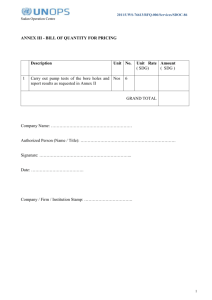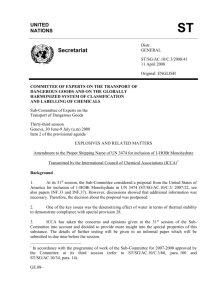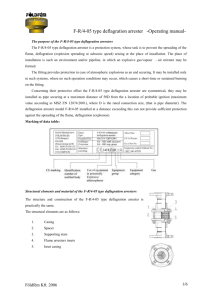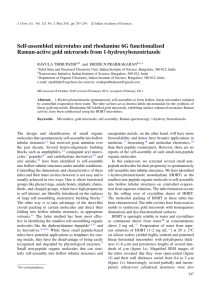Test Report
advertisement
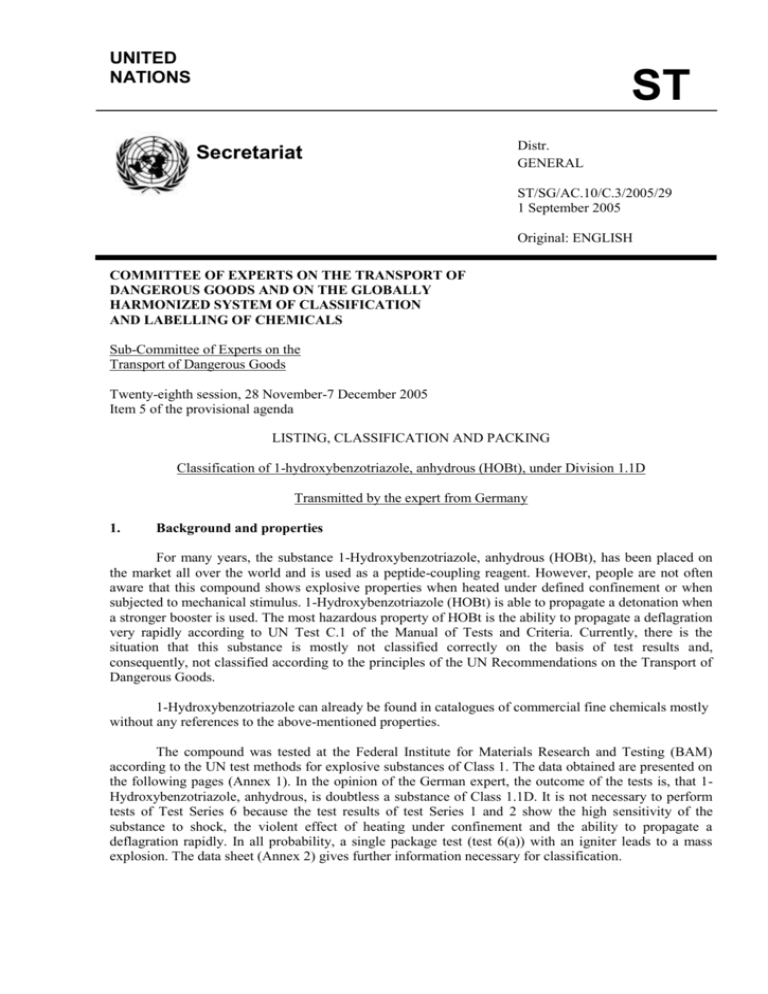
UNITED NATIONS Secretariat Distr. GENERAL ST ST E ST/SG/AC.10/C.3/2005/29 1 September 2005 Original: ENGLISH COMMITTEE OF EXPERTS ON THE TRANSPORT OF DANGEROUS GOODS AND ON THE GLOBALLY HARMONIZED SYSTEM OF CLASSIFICATION AND LABELLING OF CHEMICALS Sub-Committee of Experts on the Transport of Dangerous Goods Twenty-eighth session, 28 November-7 December 2005 Item 5 of the provisional agenda LISTING, CLASSIFICATION AND PACKING Classification of 1-hydroxybenzotriazole, anhydrous (HOBt), under Division 1.1D Transmitted by the expert from Germany 1. Background and properties For many years, the substance 1-Hydroxybenzotriazole, anhydrous (HOBt), has been placed on the market all over the world and is used as a peptide-coupling reagent. However, people are not often aware that this compound shows explosive properties when heated under defined confinement or when subjected to mechanical stimulus. 1-Hydroxybenzotriazole (HOBt) is able to propagate a detonation when a stronger booster is used. The most hazardous property of HOBt is the ability to propagate a deflagration very rapidly according to UN Test C.1 of the Manual of Tests and Criteria. Currently, there is the situation that this substance is mostly not classified correctly on the basis of test results and, consequently, not classified according to the principles of the UN Recommendations on the Transport of Dangerous Goods. 1-Hydroxybenzotriazole can already be found in catalogues of commercial fine chemicals mostly without any references to the above-mentioned properties. The compound was tested at the Federal Institute for Materials Research and Testing (BAM) according to the UN test methods for explosive substances of Class 1. The data obtained are presented on the following pages (Annex 1). In the opinion of the German expert, the outcome of the tests is, that 1Hydroxybenzotriazole, anhydrous, is doubtless a substance of Class 1.1D. It is not necessary to perform tests of Test Series 6 because the test results of test Series 1 and 2 show the high sensitivity of the substance to shock, the violent effect of heating under confinement and the ability to propagate a deflagration rapidly. In all probability, a single package test (test 6(a)) with an igniter leads to a mass explosion. The data sheet (Annex 2) gives further information necessary for classification. ST/SG/AC.10/C.3/2005/29 page 2 2. Proposal Considering the test results obtained (Annex 1), it is proposed to assign the substance 1-Hydroxybenzotriazole, anhydrous, to Division 1.1D. Proper shipping name : 1-Hydroxybenzotriazole, anhydrous Class or Division UN number Concentration Subsidiary Risks Special Provisions Packing Method : : : : : : 1.1D xxxx 100 % (-) (-) Packing instruction 112(c). Special packing instruction PP48: For UN Nos. 0504 and xxxx, metal packagings shall not be used . ST/SG/AC.10/C.3/2005/29 page 3 Annex 1 Annex 1 (English only) Test Report 1. Name of substance : 1-Hydroxybenzotriazole, anhydrous 2. 2.1 2.2 2.3 2.4 2.5 2.6 General data Composition Molecular formula Physical form Colour Apparent density Particle size : : : : : : 100 % 1-hydroxybenzotriazole, anhydrous C6H5N3O Fine crystalline powder White to light beige 454 kg/m3, when crystalline not determined 3. Box 2 : 3.1 3.2 Answer Exit : : Is the substance manufactured with the view to producing a practical explosive or pyrotechnic effect? No Go to Box 3 4. 4.1 4.2 4.3 Box 3 Propagation of Detonation Sample conditions Observations : : : : 4.4 4.5 : 4.6 4.7 Result Effect of heating under confinement Sample conditions Observations 4.8 Result : : : : Test Series 1 UN test A.1 Ambient temperature, 425 g Fragmentation into 4 pieces, no substance remains “+”, propagation of detonation Koenen test (test 1(b)) Mass 13 g Limiting diameter 10.0 mm Fragmentation type “F” (time to reaction 12 s, duration of reaction 0 s) “+”, shows some explosive effects on heating under confinement 4.9 Effect of ignition under confinement 4.10 Sample conditions 4.11 Observations : : : 4.12 Result 4.13 Exit : : Time/pressure test (test 1(c)(i) Ambient temperature Time for a pressure rise from 690 to 2070 kPa < 0.5 ms! “+”, propagation of deflagration Go to box 4 5. 5.1 5.2 Box 4 Answer from Test Series 1 Exit : : : Is it an explosive substance? Yes Go to box 5 6. 6.1 Box 5 Sensitivity to shock : : 6.2 Sample conditions : Test Series 2 BAM 1“ steel tube test, standard detonator 0.6 g PETN Ambient temperature, mass 63.5 g ST/SG/AC.10/C.3/2005/29 page 4 Annex 1 6.3 Observations : 6.4 Result : 6.5 Effect of heating under confinement Sample conditions Observations : : : 6.6 6.7 6.8 6.9 Result Effect of ignition under confinement 6.10 Sample conditions 6.11 Observations : 6.12 Result 6.13 Exit : : 7. Box 6 : 7.1 7.2 7.3 Answer from Test Series 2 Conclusion Exit : : : 8. 8.1 8.2 8.3 Box 9 Thermal stability Remark Observations : : : : 8.4 8.5 8.6 8.7 8.8 8.9 8.10 8.11 8.12 Result Impact sensitivity Sample conditions Observations Result Friction sensitivity Sample conditions Observations Result : : : : . : : : : : : : No fragmentation, no substance remains, deflagration “-“, not sensitive to shock Koenen test (test 2(b)) Mass 13 g Limiting diameter 10.0 mm Fragmentation type “F” (time to reaction 12 s, duration of reaction 0 s) “+”, violent effect on heating under confinement Time/pressure test (test 2(c)(i) Ambient temperature Time for a pressure rise from 690 to 2070 kPa < 0.5 ms! “+”, propagation of deflagration Go to box 6 Is the substance too insensitive for acceptance into Class 1? No Substance to be considered for Class 1 (box 8) Go to box 9 8.13 Exit : Test Series 3 75 °C/48 hour test (test 3(c)) Test not performed Melting point 158 °C (DSC, 5 K/min); decomposition above the melting point “-“, thermally stable BAM fallhammer test (test 3(a)(ii)) as received Limiting impact energy 10 J “-“, not too dangerous to transport in form tested BAM friction test (test 3(b)(i)) as received Limiting load > 360 N “-“, not too dangerous to transport in form tested Go to box 10 9. 9.1 9.2 Box 10 Answer from test 3(c) Exit : : : Is the substance thermally stable? Yes Go to box 11 10. Box 11 : Is the substance too dangerous for transport in the form in which it was tested? No Go to box 18 10.1 Answer from Test Series 3 10.2 Exit : : ST/SG/AC.10/C.3/2005/29 page 5 Annex 1 11. Conclusion 11.1 Exit : : PROVISIONALLY ACCEPT INTO CLASS 1 Apply the Class 1 assignment procedure It should not be necessary to perform tests of Test Series 6 because the test results of Test Series 1 and 2 show the high sensitivity of the substance to shock, the violent effect of heating under confinement and the ability to propagate a deflagration very rapidly. In all probability, a single package test (test 6(a)) with an igniter leads to a mass explosion. Therefore, the substance 1-Hydroxybenzotriazole, anhydrous, should be a candidate of Division 1.1D. Proposed assignment Proper shipping name : 1-Hydroxybenzotriazole, anhydrous Class or Division UN number Concentration Subsidiary Risks Special Provisions Packing Method : : : : : : 1.1D xxxx 100 % (-) (-) Packing instruction 112(c). Special packing instruction PP48: For UN Nos. 0504 and xxxx, metal packagings shall not be used . ST/SG/AC.10/C.3/2005/29 page 6 Annex 2 Annex 2 (English only) Figure 1 DATA SHEET TO BE SUBMITTED TO THE UNITED NATIONS FOR NEW OR AMENDED CLASSIFICATION OF SUBSTANCES Submitted by Germany August 2005 Supply all relevant information, including sources of basic classification data. Data should relate to the product in the form to be transported. State test methods. Answer all questions - if necessary state "not known" or "not applicable" - If data is not available in the form requested, provide what is available with details. Delete inappropriate words. Section 1. SUBSTANCE IDENTITY 1.1 Chemical name 1-Hydroxybenzotriazole 1.2 Chemical formula C6H5N3O 1.3 Other names/synonyms 1-Hydroxy-1H-benzotriazole; 1-Hydroxybenzotriazole anhydrous; HOBt; N-Hydroxybenzotriazole; N-Hydroxy1,2,3-benzotriazole; 1H-Benzotriazole, 1-hydroxy- 1.4.1 UN number 1.5 1.4.2 CAS number 2592-95-2 Proposed classification for the Recommendations 1.5.1 proper shipping name (3.1.21) 1-Hydroxybenzotriazole, anhydrous (HOBt) 1.5.2 class/division 1.1 D subsidiary risk(s) packing group 1.5.3 proposed special provisions, if any 1.5.4 proposed packing instruction(s) P112(c), PP48 Section 2. PHYSICAL PROPERTIES 2.1 Melting point or range 157-158 °C 2.2 Boiling point or range °C not applicable (n. a.) 1 This and similar references are to chapters and paragraphs in the Model Regulations on the Transport of Dangerous Goods. ST/SG/AC.10/C.3/2005/29 page 7 Annex 2 2.3 Relative density at : 2.3.1 15 °C 2.3.2 20 °C Apparent density about 454 kg/m3 2.3.3 50 °C 2.4 Vapour pressure at : 2.4.1 50 °C n. a 2.4.2 65 °C n. a kPa kPa n. a m2/s 2.5 Viscosity at 20 °C2 2.6 Solubility in water at 20 °C < 1 mg/l 2.7 Physical state at 20°C (2.2.1.11) solid/liquid/gas2 2.8 Appearance at normal transport temperatures, including colour and odour crystalline powder; white to light beige; nearly odourless 2.9 Other relevant physical properties danger of deflagration and dust explosion Section 3. FLAMMABILITY 3.1 Flammable vapour 3.1.1 Flash point (2.3.31) n. a °C oc/cc 3.1.2 Is combustion sustained? (2.3.1.31) yes/no 3.2 Autoignition temperature 3.3 Flammability range (LEL/UEL) 3.4 Is the substance a flammable solid? (2.4.21) yes/no °C % 3.4.1 If yes, give details The substance propagates a deflagration very rapidly and shows therefore also the properties of a flammable solid but on the basis of the test results (see test report) this substance should be classified as an explosive substance of class 1 Section 4. CHEMICAL PROPERTIES 4.1 2 Does the substance require inhibition/stabilization or other treatment such as nitrogen blanket to prevent hazardous reactivity? yes/no If yes, state: 4.1.1 Inhibitor/stabilizer used . 4.1.2 Alternative method . 4.1.3 Time effective at 55 °C 4.1.4 Conditions rendering it ineffective See definition of "liquid" in 1.2.1 of the Model Regulations on the Transport of Dangerous Goods. ST/SG/AC.10/C.3/2005/29 page 8 Annex 2 4.2 Is the substance an explosive according to paragraph 2.1.1.1? (2.11) yes/no 4.2.1 If yes, give details see Test Report 4.3 Is the substance a desensitized explosive? (2.4.2.41) yes/no 4.3.1 If yes, give details 4.4 Is the substance a self-reactive substance? (2.4.11) yes/no If yes, state: 4.4.1 exit box of flow chart What is the self-accelerating decomposition temperature (SADT) for a 50 kg package? Is the temperature control required? (2.4.2.3.41) yes/no 4.4.2 proposed control temperature for a 50 kg package °C 4.4.3 proposed emergency temperature for a 50 kg package °C 4.5 Is the substance pyrophoric? (2.4.31) yes/no 4.5.1 If yes, give details 4.6 Is the substance liable to self-heating? (2.4.31) yes/no 4.6.1 If yes, give details 4.7 Is the substance an organic peroxide (2.5.11) yes/no °C If yes state: 4.7.1 exit box of flow chart ... What is the self accelerating decomposition temperature (SADT) for a 50 kg package? Is temperature control required? (2.5.3.4.11) yes/no 4.8 4.7.2 proposed control temperature for a 50 kg package °C 4.7.3 proposed emergency temperature for a 50 kg package °C Does the substance in contact with water emit flammable gases? (2.4.41) yes/no 4.8.1 If yes, give details 4.9 Does the substance have oxidizing properties (2.5.11) yes/no 4.9.1 If yes, give details 4.10 Corrosivity (2.81) to: no data available, metal packagings should not be used 4.10.1 mild steel mm/year at °C 4.10.2 aluminium mm/year at °C 4.10.3 other packaging materials (specify) 4.11 Other relevant chemical properties mm/year at °C .. mm/year at °C °C ST/SG/AC.10/C.3/2005/29 page 9 Annex 2 Section 5. HARMFUL BIOLOGICAL EFFECTS 5.1 LD50, oral (2.6.2.1.11): > 2000 mg/kg, Animal species: rat 5.2 LD50, dermal (2.6.2.1.21): no data available 5.3 LC50, inhalation (2.6.2.1.31): no data available or 5.4 Saturated vapour concentration at 20 °C (2.6.2.2.4.31): no data available 5.5 Skin exposure (2.81) results: “mild” 5.6 Other data 5.7 Human experience mg/kg, Animal species mg/litre ml/m3 Exposure time Animal species hours ml/m3 Exposure time hours/minutes 24 hours (500 mg) Animal species rabbit Section 6. SUPPLEMENTARY INFORMATION 6.1 Recommended emergency action 6.1.1 6.1.2 6.2 Fire (include suitable and unsuitable extinguishing agents) compatible with all established extinguishing agents Spillage cover spilled substance with water Is it proposed to transport the substance in: 6.2.1 Bulk Containers (6.81) yes/no 6.2.2 Intermediate Bulk Containers (6.51)? yes/no 6.2.3 Portable tanks (6.71)? yes/no If yes, give details in Sections 7, 8 and/or 9. Section 7. BULK CONTAINERS (only complete if yes in 6.2.1) 7.1 Proposed type(s) Section 8. INTERMEDIATE BULK CONTAINERS (IBCs) (only complete if yes in 6.2.2) 8.1 Proposed type(s) Section 9. MULTIMODAL TANK TRANSPORT (only complete if yes in 6.2.3) 9.1 9.2 9.3 9.4 9.5 9.6 9.7 Description of proposed tank (including IMO tank type if known) Minimum test pressure Minimum shell thickness Details of bottom openings, if any Pressure relief arrangements Degree of filling Unsuitable construction materials ________________


